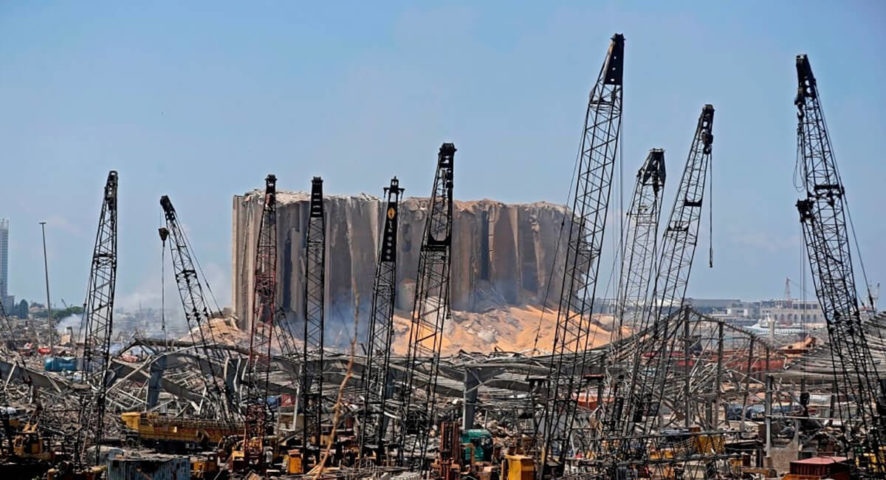
An explosion is a rapid increase in volume and release of energy in an extreme manner. Explosions occur both naturally or are man-made. The come in different forms and have several types. In the case of Beirut, the explosion that took place on August 4th 2020 that decimated the city and shook the entire region; including nearby countries as well as Cyprus, was a chemical explosion.
The explosion was supposedly caused by 2,750 tons of ammonium nitrate stored inside one of the city’s port “Hangar No.12”. This ammonium nitrate which has the chemical formula NH₄NO₃ is Produced as small porous pellets, or “prills” and is the world’s most commonly used fertilizer. Packaged in large industrial size bags containing 1 ton each; they lay in Beirut port for years until that fateful day.
On its own, Ammonium nitrate is not an explosive. It needs a catalyst. It is routinely used in bombs to alongside a combustible agent such as gunpowder to fully explode. The disintegration of ammonium nitrate is the source of oxygen that allows flammable materials to maintain combustion within the blast.
For an industrial ammonium nitrate disaster to occur, a lot needs to go wrong. Tragically, such was the case in the city of Beirut, and specifically inside its port.
So, what went wrong?
Ammonium Nitrate does not burn on its own
Lebanese authorities have indicated that the 2,750 ton shipment of ammonium nitrate was seized from a ship back in 2013 and has been stored in the port ever since. Shy attempts by successive authorities did not succeed in moving or getting rid of those dangerous chemicals in over 7 years. After several requests by port authorities to the government and the judiciary from 2013 to 2017, the issue was effectively forgotten.
Dr. David Slater, Honorary Professor in Cardiff University, when speaking of the deadly explosion in Beirut said: “It [Ammonium Nitrate] is dangerous because it is considered innocuous – not toxic…” The longer the ammonium nitrate lay there, the more safety concerns slowly dissipated.
The Furnace
At high enough temperatures, ammonium nitrate can intensely decompose on its own. The decomposition of ammonium nitrate results in a massive emission of gasses such as nitrogen oxide and water vapor which create an explosion.
It’s quite difficult for a flame to cause the ammonium nitrate to explode; especially 2750 tons of them spread out in a large hangar. The fire would need to be strong, sustained, and confined within the same area as the chemical. Videos taken of the blast show the cloud above the explosion in a characteristic brown red NO2 plume of smoke consistent with ammonium nitrate explosions, and also confirmed by Dr. Slater.
This is where the fireworks come in. According to Lebanese authorities, stored in the same hangar as the 2750 tons of ammonium nitrate was a shipment of fireworks that triggered the explosion after being ignited by an unknown cause. Video footage of the hangar moments after the first explosion and seconds before the primary explosion showed sustained and increasing explosions of fireworks, as smoke and fumes filled the hangar. In these brief moments, the hangar became a furnace. Temperatures inside rose violently as the ammonium nitrates were warming up setting the stage for a full-fledged explosion.
The Aftermath
It is difficult to measure the extent of the explosion. Some experts including Dr. Slater said that the explosion seems to indicate a smaller level of impact than 2750 tons of ammonium nitrate would cause. This can be explained through two possibilities:
The first is reports claiming that many of the chemicals have been stolen throughout the years they have been left unclaimed inside the port. These chemicals can be used in many industries, but also are linked to many terrorist activities. Obtaining these chemicals is difficult, and some of them being stolen is a likely scenario. The second possibility is due to the inherent difficulty in igniting ammonium nitrate. It is very likely that a portion of the stored ammonium nitrate did not decompose and simply dispersed along the blast radius.
The explosion was a result of gross negligence towards storing over two thousand tons of explosive material in a heavily inhabited area, and gross incompetence of not realizing that all these chemicals need to explode is an ignition source such as the fireworks they placed right next to them. It is not yet clear when the fireworks were stored inside hangar number 12 and how they were ignited. However, ever since they were stored; Beirut had been sitting on a ticking time bomb. When all is set up for disaster, the trigger becomes a matter of when, not how. What caused the initial spark will be up for debate forever. The possibility of a terrorist attack by foreign entities can never be dismissed. The real truth of how it was caused can never be known without a reasonable doubt. It is the perfect metaphor for Lebanon: A country ruled through a system so volatile and corrupt that under its conditions, it is simultaneously someone’s fault and everyone’s fault. The only question now is when.

